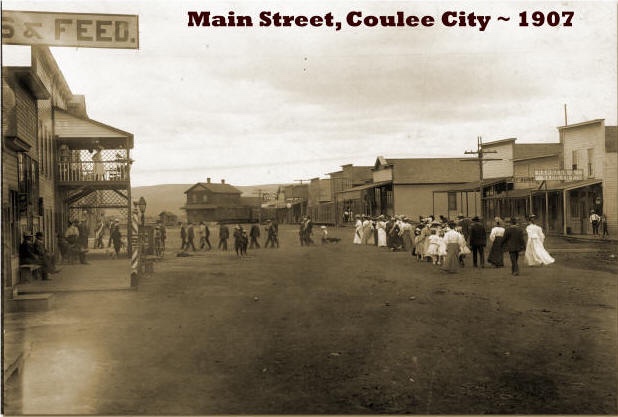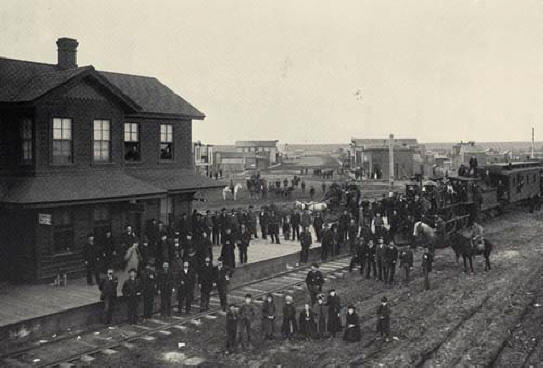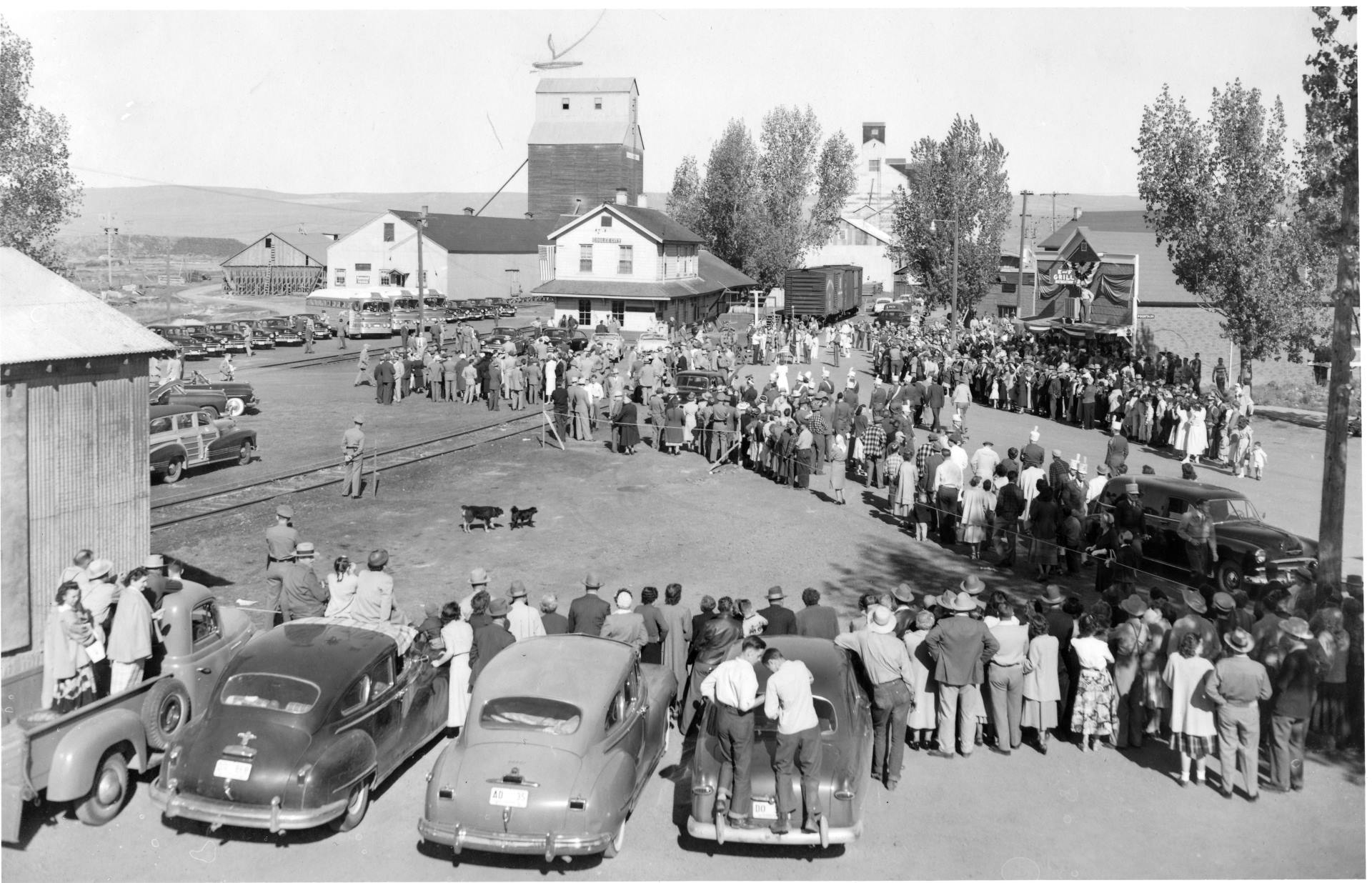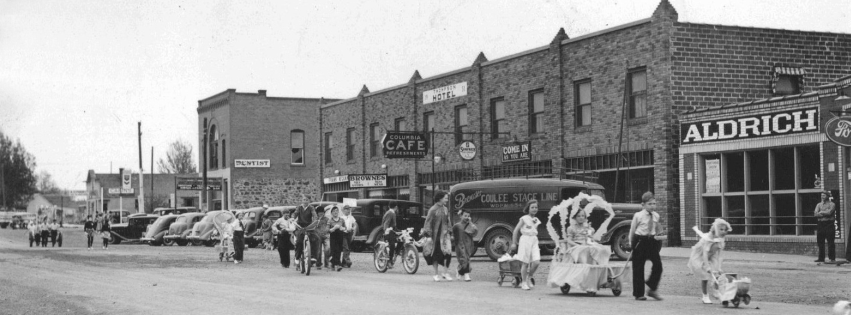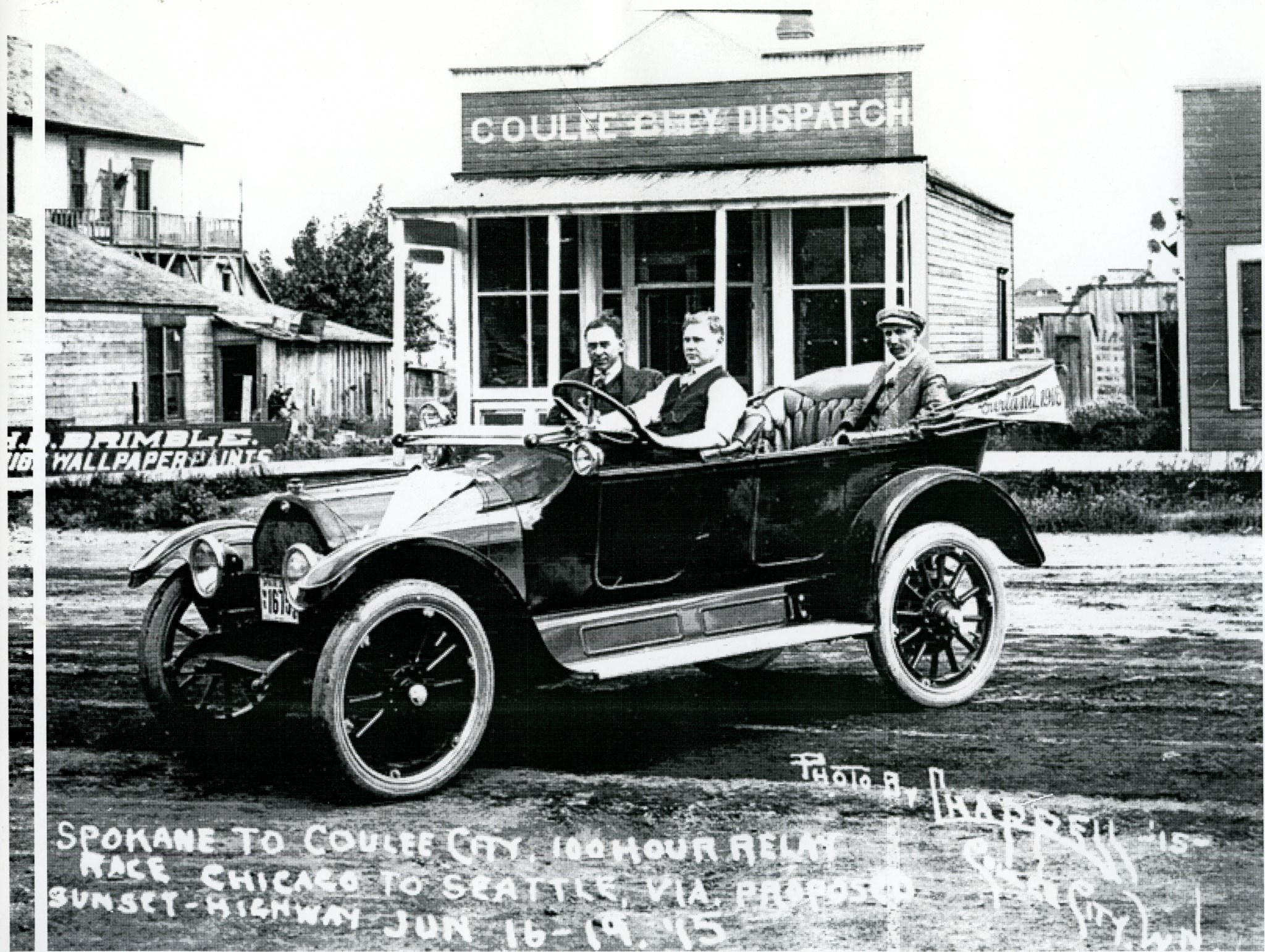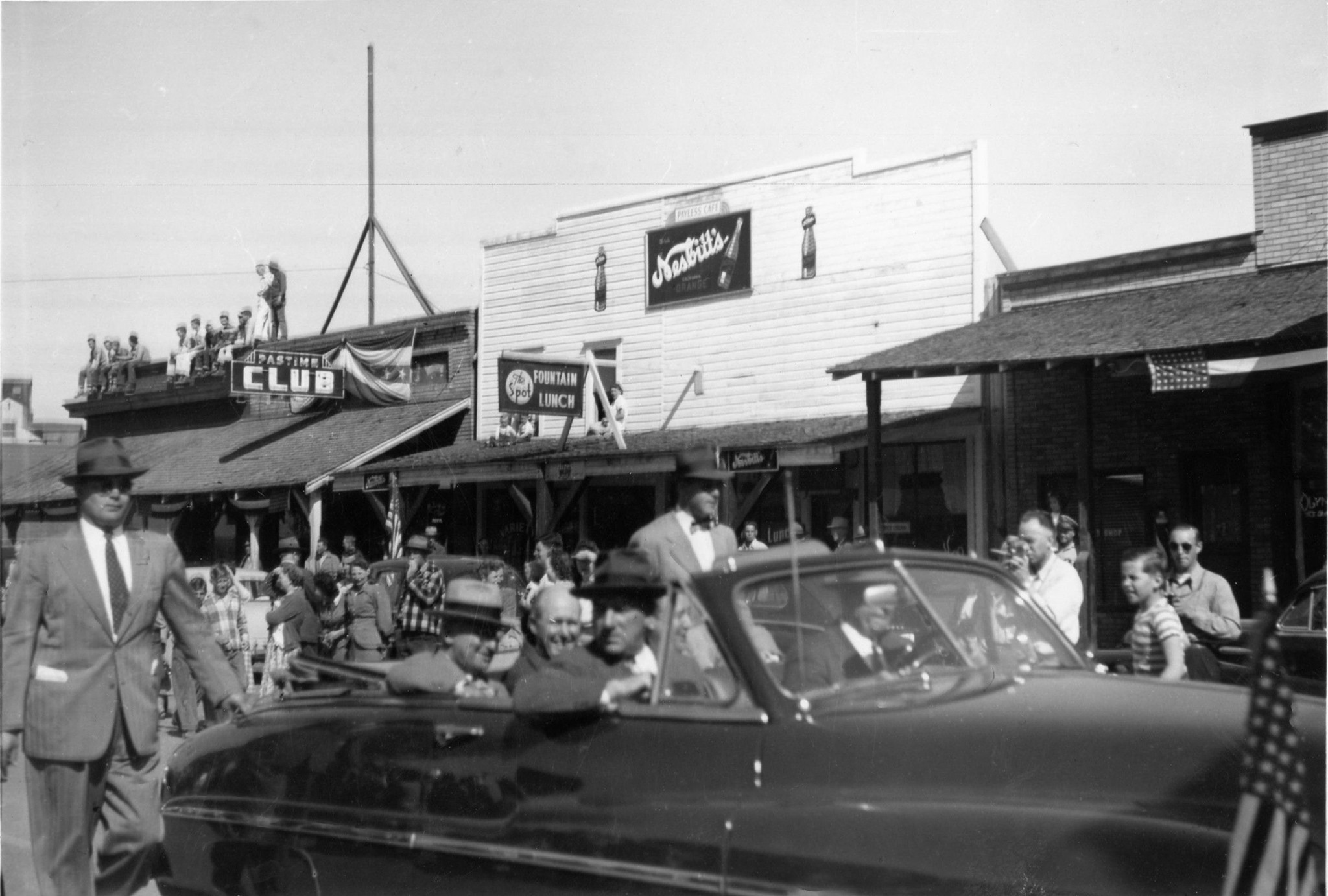Situated on a level piece of ground in the bed of the Grand Coulee, the picturesque, and perhaps one of the most interesting of the small communities in the Grand Coulee area from a historical point of view lies Coulee City, Washington.
Located at what was known as early as 1858 as the middle pass across the canyon - the site where Coulee City now stands was for many years known as McEntee's Crossing of the Grand Coulee. As is so often the case, the history of an area is the story of the unflinching and energetic characters who came out west in search of adventure and found it in the taming of the wilderness.
Phillip McEntee was that kind of man. In 1877 from Ming in Bear Gulch, Montana, came to Washington and joined a group of surveyors who were trying to locate and lay out a road from Ritzville by way of White Bluffs. The party camped that winter near Lake Chelan and by the spring, the records show that the area had impressed Mr. McEntee. After the surveying job was complete, McEntee bought cattle with the money he earned and returned to build the first log cabin in the spring of 1881 on what would be the outskirts of Coulee City.
During this time when this portion of the state (then a territory) was uninhabited except by Indians and an occasional white man. Mr. McEntee would start from where Coulee City now stands with a herd of cattle, drive them across several hundred miles of unbroken wilderness up into British Columbia where he would sell them to miners, together with his pack horses, and make the returning journey on foot.
During the following few years, other pioneers entered the area. Among those who shared the hardships of this wilderness were Dan Paul, John R. Lewis, Tony Richardson, Charles Sprague and others - but it was now 1888 that enough settlers were in the area to warrant the establishment of a store.
In June of 1888 Mr. George R. Roberts who had come to Douglas County in 1883 opened a general store about 3/4 of a mile north of the present business portion of town. A post office called McEntee, in honor of the first settler, was established. The town of McEntee was enlarged in the fall of 1888 by the establishment of a second store and blacksmith shop by Levi Salmon, and Dan Twining opened a saloon.
The little village of McEntee lost its identity with the platting and building up of the town of Coulee City in the spring and summer of 1890. The town was platted and dedicated in the spring of 1890 by Levi Salmon. The post office of McEntee was transferred to the new location and was thereafter known as Coulee City. Coulee City's history really dates from the building of the Central Railroad to that point, or more properly, from the contemplated construction of the road to the crossing of the Grand Coulee.
Now we find a meat market operated by Dan Paul, a barber shop, Hill and Evans Dealers in Lumber & Coal, a Restaurant operated by John Brown, Adron and Thruman Livery Stable, Frank A. Lasekamp selling men's clothes and shoes, Bisbee and Cooper, Builders.
In June 1890, the Coulee City News said "Only surprise is pictured on the faces of those who visit our city after only a few weeks absence. They hardly realize that in so short a time such substantial business houses could be constructed."
In 1892 Owen Wister stayed a short time in Coulee City. Owen Wister is the author of "The Virginian".
With a population of about 300 at this time, this little western town was in line for the advent of land settlers and a new grand future dawning for the region west of the Grand Coulee known as Big Bend Country.
In 1901, early pioneer Everett Rice and his family moved to Coulee City from Missouri and farmed here most of his life. By 1906, binders, headers and threshing machines were in use on the farms. Between 1900 and 1925, prices for a bushel of wheat fluctuated between 41 cents and $2 a bushel. The crop of 1916 produced 16 bushels per acre.
In 1902 there were 7 gambling halls in town, and also that year notorious killer Harry Tracey came through town. Folks cut bits of tail from his horse as a souvenir. In 1906 Clifton Ham and Archie Tucker began planting orchards northeast of town. By 1910 over 300 acres of orchards produced 90 rail cars of peaches, pears and apples.
In 1903 the Coulee City population was booming at 122. By 1907 Coulee City became incorporated as a fourth-class city. In 1924 the name of the town was shortened to Coulee. In 1910 the Sunset highway (now known as highway 2) was completed from Spokane across the Big Bend.
The first town Marshall was also hired in 1907, and in 1908 the citizens voted the town dry, and it remained under prohibition until 1932.
In 1911 Charles Weller started a gasoline-powered generating plant in Coulee with an initial capacity of 25 kilowatts. With 2 miles of line, he served 100 customers and 20 streetlights. Cement sidewalks were poured on Main St. in 1916. The town issued bonds for a sewer system in 1919.
When there was talk about diverting the Colombia river for irrigation, the builder of the Panama Canal, George Goethals, came to survey the site. He stayed at the Thompson Hotel while in town, but his report was negative on the feasibility of building a dam.
Through good times and bad, outlaws and in-laws, storms and drought, Coulee City continues to thrive. Ours is a proud heritage; one those hardy and courageous pioneers would look upon with favor. Coulee City no longer bears a strong resemblance to the town as it first appeared in 1890. Gone are the farms and grazing areas that once bordered the town on the north. This land is now under the waters of Banks Lake which provides water to irrigate over one million acres in the Columbia Basin area. Banks Lake and Sun Lakes State Park-to the south of the city- provide fishing, swimming, boating and camping areas. Hunting, hiking, horseback riding, cross country skiing and golfing are also enjoyed in the coulee. Add to that scenic wonder Dry Falls, and the Last Stand Rodeo on Memorial day. These attractions combine to make Coulee City a major recreational location and perfect place to visit - not to mention a great place to live!
Truman’s Visit to Grand Coulee Dam
by Dan Bolyard
With great fanfare, President Harry Truman visited the Grand Coulee Dam site for, among other things, a dedication.
He arrived in Spokane at about 3 am, where his 14-car streamlined train was turned over by the Union Pacific to the Northern Pacific. From there it was parked at the Spokane depot, before departing for Coulee City at 4:30 am.
At 8:15 am, the train arrived at Coulee City, where a crowd of about 1200 people were waiting for him. The American Legion drum and bugle corps from Wenatchee played as the train rolled to a stop. He had not planned to speak there, but responded to Senator Warren Magnuson’s appeal to talk.
“We are going to Coulee Dam this morning to discuss many things and explain many things we think people ought to know. We will explain why some people don’t want the CVA (Columbia Valley Authority). I think the people do want it.”
He then told a humorous story.
“I have told this story in about every town in which I have stopped, so I guess it is good here.”
The story concerned early days when stage coaches met incoming trains. He said one fellow complained that the stage coach from Bridgeport never met the train at Coulee City nor did the Coulee City train make connections with the stage coach. The men found out later that the Coulee City hotel men had made a deal with the stage driver and the railroad engineer to cause more hotel rooms to be booked in town.
A homemade cake, a replica of the South Dam, was presented to the President by the Coulee City Chamber of Commerce.
From there the President was part of a 21-car caravan that drove up the Grand Coulee.
Once at the Mead circle, near the dam, he dedicated the dam and the Franklin D. Roosevelt Lake behind the dam to the late President Roosevelt. It was estimated that between 11,000 and 15,000 people were at the dedication.
Truman was then given a special tour of the dam, where he was shown the generating plants that had produced the electricity; these plants helped build the atomic bomb and other weapons used during the recent war.
Then the entire group traveled to the other side of the dam where many VIPs were present, including Washington Governor Arthur B. Langlie, manager of the Columbia Basin Project Frank Banks, and former Washington Governor Clarence Martin.
After speaking there, the 21-car caravan then left with the President for Wilbur, where they would rejoin the train for the trip back to Spokane.
The plaque stands today, along with a bust of President Roosevelt, as a memory to the dam and the event that day.

